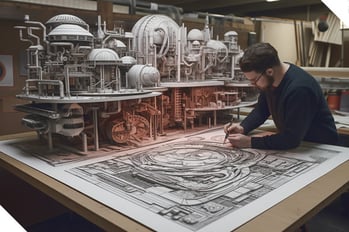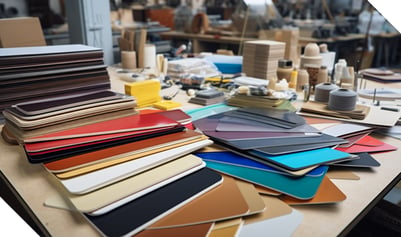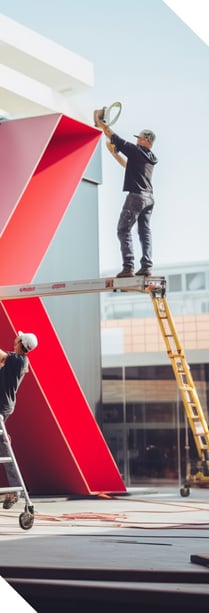Amidst the evolution of pushing event boundaries is a trend that has emerged that combines technology with tangible creativity: 3D signage. No longer confined to the realms of manufacturing or hobbyists, 3D printing now weaves its magic into the heart of immersive events. This guide aims to illuminate the transformative potential of 3D printed signage, offering insights into its unique impact, and providing a step-by-step journey from conceptualization to implementation. Whether you're an event planner, brand strategist, or just someone with a penchant for innovation, dive in to discover how 3D signage can elevate your next event to a multi-dimensional experience.
The Transformative Potential of 3D Signage
- Personalization: The allure of any event is often in its ability to connect on a personal level. Traditional signage, while effective, can sometimes fall flat in capturing individual attention. With 3D printed signage, personalization reaches new heights. Imagine tailoring designs that resonate with specific demographics, or even crafting unique messages for different attendee groups. The depth, structure, and tangible nature of 3D signage enables a direct, personalized communication like never before.
- Immersion: Flat banners and posters have their place, but they lack the depth that engages all the senses. 3D printed signage, however, introduces a tactile dimension. Attendees can not only see but also feel the contours, shapes, and textures. This multi-sensory interaction ensures that the message isn't just seen—it's experienced. By creating a more immersive environment, attendees are likely to be more engaged, ensuring the event's objectives are more profoundly achieved.
- Sustainability: In a world increasingly conscious of its ecological footprint, 3D printing offers an environmentally-friendly solution. Traditional manufacturing methods often involve wasteful practices, such as carving out material, leading to excess waste. In contrast, 3D printing is an additive process, meaning material is only used where needed. Additionally, with the rise of eco-friendly printing materials, event planners can confidently create without compromising on the planet's wellbeing.
- Scalability: One of the unsung advantages of 3D printed signage is its scalability. Whether you're hosting a cozy seminar or orchestrating a grand expo, 3D signage can be adapted to fit any scale. Small intricate details for boutique events or larger-than-life installations for massive audiences, 3D printing accommodates all. This flexibility ensures consistent branding and thematics, regardless of the event's size.
The transformative potential of 3D printed signage lies not just in its innovative use of technology, but also in its ability to deeply resonate with attendees on multiple levels. By embracing this medium, brands can craft experiences that are not only visually compelling but also tactile, sustainable, and adaptable to any event's unique needs.
Conceptualizing Your 3D Printed Signage
- Know Your Audience: At the core of any successful event or activation is a deep understanding of the audience. As you approach the task of crafting your 3D signage, start by identifying the demographics, preferences, and expectations of your attendees. Are they tech-savvy millennials looking for an Instagram-worthy moment? Or perhaps industry professionals seeking informative and impactful visuals? The key to effective signage lies in its resonance. By aligning your 3D designs with the tastes and preferences of your audience, you lay the groundwork for a more impactful connection.
 Theme & Consistency: Every event carries a distinct mood, message, or theme. Whether it's a futuristic tech conference or a vintage art deco gala, the ambiance sets the tone for the experience. Your 3D printed signage should not only complement this theme but amplify it. Consider the overarching motifs, colors, and aesthetics when designing your signage. Consistency is paramount. Every piece of signage, whether large or small, should echo the same thematic resonance, ensuring a cohesive and immersive experience for attendees.
Theme & Consistency: Every event carries a distinct mood, message, or theme. Whether it's a futuristic tech conference or a vintage art deco gala, the ambiance sets the tone for the experience. Your 3D printed signage should not only complement this theme but amplify it. Consider the overarching motifs, colors, and aesthetics when designing your signage. Consistency is paramount. Every piece of signage, whether large or small, should echo the same thematic resonance, ensuring a cohesive and immersive experience for attendees.- Location & Placement: In the world of events, location isn't just everything; it's the only thing. The placement of your 3D printed signage can significantly influence its effectiveness. Begin by mapping out the event space, identifying high-traffic areas, focal points, and potential bottlenecks. Strategically place signage in areas where attendees are likely to gather, pause, or even take photographs. Remember, the goal is to create touchpoints—moments where attendees interact with or are influenced by the signage. Thoughtful placement ensures these touchpoints leave a lasting impression.
Crafting the perfect 3D printed signage begins long before the printing process. By laying a solid conceptual foundation, considering your audience's needs, maintaining thematic consistency, and optimizing placement, you can create an experience that not only showcases your message but also deeply engages and resonates with your attendees.
Implementing Your 3D Printed Signage
 Choosing the Right Material: Material choice is crucial when it comes to event signage. The ambiance, lighting, and overall theme of your event should dictate your material selection. For indoor, upscale events, you might opt for glossy or metallic finishes that catch and reflect ambient light. Outdoor events, on the other hand, might benefit from durable plastics or composite materials that can withstand the elements. Additionally, consider the lifespan of the signage: a one-off event might not require the same durability as a recurring trade show.
Choosing the Right Material: Material choice is crucial when it comes to event signage. The ambiance, lighting, and overall theme of your event should dictate your material selection. For indoor, upscale events, you might opt for glossy or metallic finishes that catch and reflect ambient light. Outdoor events, on the other hand, might benefit from durable plastics or composite materials that can withstand the elements. Additionally, consider the lifespan of the signage: a one-off event might not require the same durability as a recurring trade show.- Printing Process: Once your design is finalized and material selected, it's time to print. Ensure you have chosen a print provider that can handle the size and intricacy of your signage. Depending on the scale of your event and the number of signages needed, the printing duration can vary. Remember to allocate ample time for this phase, especially if you're producing multiple pieces. It's always advisable to run a test print to gauge timing and ensure quality.
- Post-Processing: After the printing completes, there's usually some degree of post-processing required. This might involve cleaning up any residual support structures, sanding down rough edges, or applying finishes to enhance the look and feel of the signage. For events, where presentation is key, consider adding touches like paint, varnish, or even LED backlighting to give your signage that extra pop.
Installation Tips - Implementing your signage at the event venue requires foresight and planning.
 Consider the following factors:
Consider the following factors:
- Visibility: Ensure your signage is visible from key entry and exit points.
- Safety: Heavy signage should be securely mounted to prevent accidents.
- Accessibility: If your signage is interactive or meant to be touched, ensure it's within reach and accessible to all attendees.
- Lighting: Proper lighting can dramatically enhance the look of your 3D printed signage. Play with spotlights, ambient lighting, or even colored lights to make your signage stand out.
- Mobility: For multi-day events or traveling exhibitions, consider how easily the signage can be assembled, disassembled, and transported.
Successfully implementing 3D printed signage at your event is the culmination of careful planning, design, and execution. The goal is to create an environment where the signage enhances the event's theme, directs attendees seamlessly, and adds a layer of tactile interaction that traditional signs can't offer.
Including 3D Signage At Your Next Event
The realm of events and activations is continuously evolving, always be on the lookout for innovative ways to captivate and engage. 3D printed signage, while already making notable impacts, is just scratching the surface of its potential. As we move forward, the synergy of design, technology, and personalization will redefine how we perceive and interact with event spaces. For brands and organizers, staying abreast of these shifts and embracing the transformative potential of 3D printed signage will be pivotal in crafting future-forward events.
